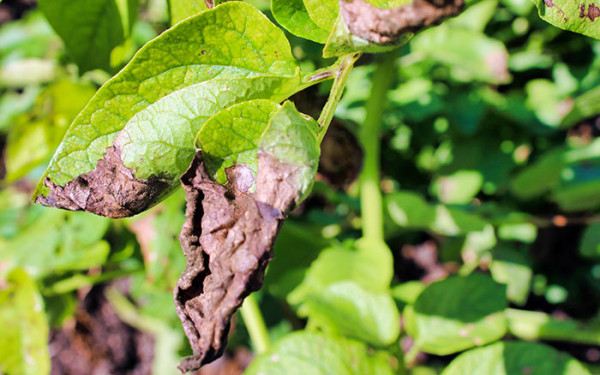Potatoes and tomatos are the vegetables most commonly affected by blight. It’s a very common and widespread disease and is more serious in wet seasons. It was the direct cause of the 19th century Irish potato famine. Read on to find out more about the disease, blight and what to look out for, especially on potatoes and tomatoes.
What is blight?
Potato and tomato blight, or Phytophthora infestans, is a serious fungal disease that thrives in warm, wet conditions. It’s often called ‘late blight’ to avoid confusing it with another much less serious potato disease, called ‘early blight’.
Late blight attacks and affects the leaves and crop of both potatoes and tomatoes. It causes both crops to rot.
Watch out for tell-tale brown patches appearing on the leaf edges and tip of potato and tomato plants. This is then followed by a sudden collapse of the brown leaves into a watery mass on the ground.
Dark streaks and spots will also appear on the green fruit and stems of tomato plants.
If the weather has been damp, you might also see a ring of white mould growing on the underside of the affected leaves.
It will spread quickly so fast action is needed when spotted. Although it’s commonly called ‘late blight’, the symptoms can appear from early summer.

How to control late blight on potatoes
Firstly, choose varieties that have some resistance such as the Sarpo varieties. It’s wise to avoid very susceptible varieties such as ‘Arran Pilot’ and ‘King Edward.’ The British Potato Variety Database is a good point of reference.
Grow first early varieties as they tend to escape the disease.
Earthing up potatoes as they grow can provide some protection but is not fail safe.
Removing infected leaves when first spotted could help save the crop and delay spread of the disease. However, this won’t remove the disease.
If more than a quarter of the leaves on the plant are diseased remove all the leaves, cutting them down close to the soil level. Remember to not put them on the compost heap. Instead place them in the recycling bin.
Dig up the tubers from the plants where the leaves have been removed about two weeks afterwards and use in priority to non-diseased potatoes. It’s best to avoid storing them.
Rotate the beds in which you grow your potatoes on a four-year crop rotation cycle.
Do not leave any potatoes in the soil.
There are currently no chemical controls available for use by the home gardener.

How to control late blight on tomatoes
As with potatoes, choose varieties of tomatoes said to offer some resistance to the disease. The RHS found that ‘Mountain Magic’ and ‘Crimson Crush’ performed well in this respect during their 2021 trials.
Remove infected leaves as soon as possible and place in the recycling bin. Again, do not home compost them.
Try growing varieties in a greenhouse because these tend to be less badly affected.
When watering, water at the base of the plants rather than over the leaves which will make the leaves damp and can spread diseases.
Practice a similar 4-year rotation cycle.
As with potatoes there are no fungicides currently available for use by the home gardener.


Leave A Comment